A) 1,000
B) 10,000
C) 30,000
D) 50,0000
E) 100,000
Correct Answer

verified
Correct Answer
verified
Multiple Choice
Transcription occurs in the ________, whereas translation occurs in the _________.
A) cytoplasm; nucleus
B) mitochondria; cytoplasm
C) nucleus; mitochondria
D) cytoplasm; mitochondria
E) nucleus; cytoplasm
Correct Answer

verified
Correct Answer
verified
Multiple Choice
Which type of RNA is the complement of the template strand of DNA in the nucleus?
A) ribosomal RNA (rRNA)
B) RNA polymerase
C) messenger RNA (mRNA)
D) transfer RNA (tRNA)
E) All of these are the complement of the DNA.
Correct Answer

verified
Correct Answer
verified
Multiple Choice
Which of the following molecules is a nucleotide? 
A) I only
B) II only
C) III only
D) I and II
E) II and III
Correct Answer

verified
Correct Answer
verified
Multiple Choice
Which statement BEST describes why the sugar phosphate nucleic acid backbone is on the outer part of the DNA double helix while the nitrogen bases are on the inside of the double helix?
A) The sugar phosphate backbone is hydrophilic while the bases are less polar.
B) The sugar phosphate backbone is hydrophobic while the bases are hydrophilic.
C) The sugar phosphate backbones of the two strands are bonded together.
D) The nitrogen bases are covalently bonded to each other.
E) There is no reason; the structure is just that way.
Correct Answer

verified
Correct Answer
verified
Multiple Choice
How is the amino acid attached to the tRNA molecule? 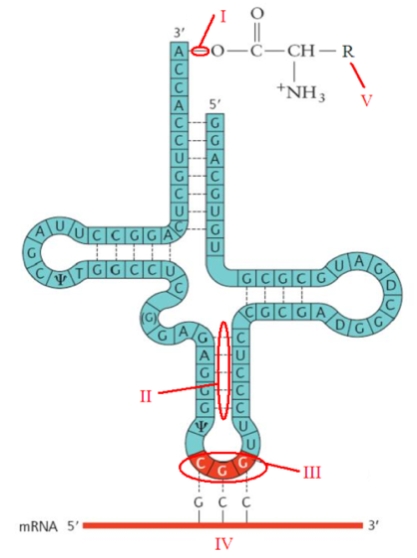
A) They are connected by dipole-dipole interactions.
B) They are connected by hydrogen bonds.
C) They are connected by ionic interactions.
D) They are connected by amide bonds.
E) They are connected by ester bonds.
Correct Answer

verified
Correct Answer
verified
Multiple Choice
What is a gene?
A) a segment of DNA containing information for assembling the sequence of amino acids for a specific protein
B) a molecule of DNA containing thousands of nucleotides
C) a change in DNA that may cause an inherited disease
D) an alteration in the DNA that is caused by environmental factors
E) All of the above are definitions of a gene.
Correct Answer

verified
Correct Answer
verified
Multiple Choice
Which statements BEST describes what occurs during translation?
A) DNA is reproduced.
B) Protein is synthesized using DNA as a template.
C) Protein is synthesized using mRNA as a template.
D) mRNA is synthesized using DNA as a template.
E) mRNA is synthesized using protein as a template.
Correct Answer

verified
Correct Answer
verified
Multiple Choice
Which choice BEST describes the interaction between DNA and a histone?
A) The negative charges on a histone attract the positive DNA.
B) The positive charges on a histone attract the negative DNA.
C) Hydrogen bonding occurs between a histone and DNA.
D) DNA forms a covalent bond with a histone.
E) There is a phosphate bond between a histone and DNA.
Correct Answer

verified
Correct Answer
verified
Multiple Choice
A mRNA sequence that codes for a protein is 5′-CAA GGG UAC-3′.Which of the following choices does NOT cause a change in the amino acid sequence?
A) 5′-CAA GCG GUA C-3′
B) 5′-CAG GGG UAC-3′
C) 5′-GAA GGG UAC-3′
D) 5′-CAA GGG UAA-3′
E) These are all mutations.
Correct Answer

verified
Correct Answer
verified
Multiple Choice
The boxed portion of the following structure represents a 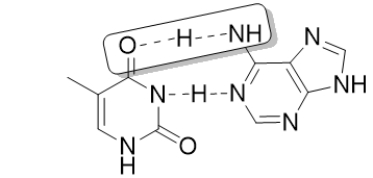
A) salt bridge.
B) hydrogen bond.
C) disulfide bridge.
D) hydrophobic interaction.
E) hydrophilic interaction.
Correct Answer

verified
Correct Answer
verified
Multiple Choice
In a nucleotide, what type of functional group joins the phosphate group to the sugar?
A) a carboxylic acid
B) a glycosidic bond
C) a monophosphate ester
D) an amide
E) an ether
Correct Answer

verified
Correct Answer
verified
Multiple Choice
The nucleoside below is found in DNA and not RNA.Which of the following statements supports this molecule being a DNA nucleoside? 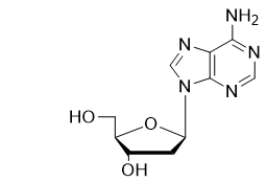
A) The molecule is the β-anomer.
B) The molecule contains a pyrimidine.
C) The molecule contains a purine.
D) The molecule contains a 2-deoxy-D-ribose.
E) The molecule contains a D-ribose.
Correct Answer

verified
Correct Answer
verified
Multiple Choice
How many chromosomes do most human cells contain?
A) 12
B) 23
C) 37
D) 46
E) The number varies from cell to cell.
Correct Answer

verified
Correct Answer
verified
Multiple Choice
What is the role of HIV protease in HIV infection?
A) It is part of transcription.
B) It is part of translation.
C) It is the enzyme that attaches to T-cells.
D) It makes the capsid.
E) It cuts polyproteins into individual proteins and enzymes.
Correct Answer

verified
Correct Answer
verified
Multiple Choice
What type of permanent alteration of the chemical structure of a gene occurs after birth?
A) an inherited mutation
B) a genetic disease
C) cervical cancer
D) altered proteins
E) an acquired mutation
Correct Answer

verified
Correct Answer
verified
Multiple Choice
All living organisms have the same
A) genes.
B) chromosomes.
C) proteins.
D) genetic code.
E) DNA sequence.
Correct Answer

verified
Correct Answer
verified
Multiple Choice
What happens when a particular protein is needed by a cell?
A) The cell dies.
B) The gene for that cell is expressed.
C) The gene for that cell is replicated.
D) The entire DNA strand containing the appropriate gene is expressed.
E) The entire DNA strand containing the appropriate gene is replicated.
Correct Answer

verified
Correct Answer
verified
Multiple Choice
In the diagram below, letter F is _______, letter E is__________, and letter B is____. 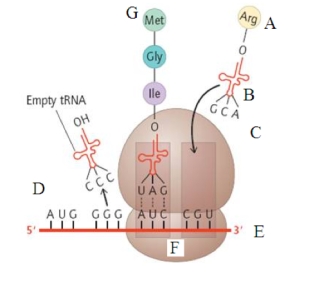
A) rRNA; mRNA; tRNA
B) rRNA; tRNA; mRNA
C) tRNA; rRNA; mRNA
D) tRNA; mRNA; rRNA
E) mRNA; rRNA; tRNA
Correct Answer

verified
Correct Answer
verified
Multiple Choice
In the following drawing of a DNA double helix, arrow II is pointing to a(n) 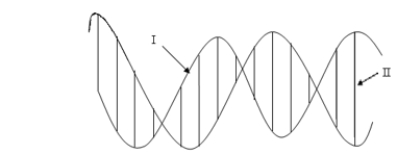
A) DNA base pair.
B) ionic bond.
C) sugar phosphate backbone.
D) polar covalent bond.
E) hydrophilic interaction.
Correct Answer

verified
Correct Answer
verified
Showing 81 - 100 of 109
Related Exams